Letter to FTC on Toyota’s Misleading Advertising
By Aaron Regunberg and David Arkush
Download the PDF here: FTC Complaint on Toyota’s Misleading Advertising
December 13th, 2023
Before the Federal Trade Commission, Washington, D.C. 20580.
Complaint seeking investigation, enforcement, and appropriate relief from Toyota Motor Corporation, and requesting policy guidance on the deceptive practice of marketing gasoline-powered cars as electric vehicles.
Outline
Introduction
I. Background and summary
A. EVs are the future of the auto industry.
B. Toyota has placed itself far behind its rivals on electric vehicles.
C. These trends threaten Toyota’s market dominance and consumer loyalty.
D. Toyota has responded to this crisis by launching a campaign to confuse consumers about EVs and the nature of its hybrid offerings.
II. EVs have different operational, cost, and emission characteristics than hybrids and plug-in hybrids
A.Electric vehicles
B. Hybrids
C. Plug-in hybrids
D. Emissions
III. Toyota’s marketing of “electrified” vehicles is deceptive
A. Toyota’s marketing is likely to mislead reasonable consumers.
1. Toyota’s “electrification” claims are misleading.
2. Toyota’s claims of climate and environmental leadership are misleading.
3. It is reasonable for consumers to find Toyota’s practices misleading.
B. Toyota’s deception is material.
C. Toyota’s deceptive marketing violates the FTC Green Guides.
D. Toyota’s deceptive marketing is in a league of its own.
E. Toyota’s deceptive marketing threatens the broader EV market.
IV. The FTC should stop these violations of the FTC Act
V. Conclusion
Introduction
Public Citizen asks the Federal Trade Commission (“FTC” or “the Commission”) to investigate and take enforcement action against Toyota Motor Corporation and Toyota Motor North America (“Toyota”) for its misleading marketing of gasoline-powered vehicles as electric vehicles (“EVs”) and to issue clear policy guidance explaining that marketing like Toyota’s is a deceptive practice prohibited by Section 5 of the Federal Trade Commission Act.
Toyota is the world’s largest automaker.[1] As the maker of the Prius hybrid vehicle, it was long considered a leader in the field of clean cars.[2] But now the market is shifting rapidly toward electric vehicles. Toyota long ignored this technology, and today it lags far behind other automakers in a market that is growing exponentially.[3]
In response to this market shift, Toyota has launched a marketing campaign that uses the term “electrified” to paint its existing hybrid models—which are gasoline-powered—as electric vehicles.[4] Through its “Beyond Zero,” “Electrified Diversified,” and “To Each Their Own Electric” marketing campaigns and other advertising practices, Toyota is mendaciously relabeling a number of cars with internal combustion engines “EVs” and representing vehicles that run on fossil fuels as “electric” and “electrified.” These representations are misleading consumers about the climate and economic benefits of Toyota’s hybrid cars as compared to EVs. Consumers typically understand the words “EVs” and “electric vehicles” to refer to cars that are fully, or at least meaningfully, electric[5]—and for that reason materially superior to hybrids regarding climate impacts, cost of ownership and maintenance, and other factors. Toyota’s practices are also introducing disinformation and confusion into the market for electric vehicles, undermining fair competition and consumer choice in one of the most important, dynamic, and fast-developing sectors in the U.S. economy.
For the benefit of consumers, fair competition, and the livable future that many consumers are attempting to use their market choices to foster, we urge the FTC to act. The Commission should investigate and take enforcement action against Toyota to end its deceptive marketing. And it should issue clear guidance in its updated Green Guides that the marketing of gasoline-powered cars as “EVs,” “electric,” or “electrified” is deceptive and prohibited under Section 5 of the FTC Act.
I. Background and summary
Toyota has fallen far behind other automakers on EVs, and the explosive growth of this sector poses a major threat to Toyota’s market dominance in the coming years. In response to this looming sales crisis, Toyota is launching a campaign to deceive and confuse consumers about the nature and proper delineation of electric vehicles—the most important and fastest-growing automotive innovation since the invention of the car.
A. EVs are the future of the auto industry.
It is hard to overstate the importance of EVs for the future of the auto industry. They are extremely popular, to the degree that demand is often “well beyond” what automakers can currently supply.[6] Indeed, the market is seeing “exponential,” “explosive” growth.[7] The global share of new EVs has increased at an average of around 50% per year since 2015[8], and EV market share has more than doubled in just the last two years.[9] Even in the face of rising interest rates, EV sales have grown by more than 50% this year—and the market is so strong that growth of over 50%, unimaginable in most industries, has been described as disappointing.[10] S&P Global Mobility forecasts that EV market share for new vehicles will reach 40% by 2030,[11] while a survey of auto executives found that on average they expect over 50% of U.S. car sales will be EVs by 2030.[12] Historically, projections such as these have overwhelmingly underestimated EV growth.[13] To give just one example, the International Energy Agency projected in 2021 that electric vehicles and plug-in hybrids would reach a combined market share of 7% to 12% by 2030.[14] The very next year, their market share was 14%.[15] Many experts believe we are nearing inflection points when growth will suddenly accelerate[16] through the steepest portion of an S-curve.[17]
B. Toyota has placed itself far behind its rivals on electric vehicles.
In this era of rapid energy transition, Toyota has “substantially miscalculated”[18] its approach to EVs. The company bet big on the development of hydrogen fuel cells over battery-powered electric vehicles,[19] and has continued to double down on hydrogen combustion[20] even as other automakers have recognized that this strategy “doesn’t seem feasible.”[21] Toyota also dumped its stake in Tesla in 2016, just as that company—and EV sales in general—began to experience explosive growth.[22] Toyota’s longtime CEO, Akio Toyoda, who led the company for almost 14 years before stepping down in April 2023, was well-known for his dislike of EVs.[23] Under his leadership, Toyota apparently held the position as late as summer 2022 that demand for EVs “would not take off for several decades.”[24] This failure to prioritize investments in electric vehicles has left Toyota far behind its rivals in this critical market, a cause for panic within the company beginning in the fall of 2022.[25]
Toyota has almost zero EV market penetration. In the first half of 2023, Toyota’s EVs represented just 0.19% of its global sales, and an even smaller fraction of global EV sales,[26] which are expected to surpass 10 million this year.[27] Toyota currently offers just two EV models in the U.S., and it produces and sells them in miniscule numbers. Regarding the first, the bZ4X, Toyota targeted sales of only 7,000 in 2022,[28] yet missed that mark by 83%, selling just 1,220.[29] After that rocky start, the automaker aims to sell just 10,000 units in the U.S. in 2023[30] and managed only 3,659 in the first half of the year.[31] The company targeted only 4,900 sales of its second EV, the Lexus RZ 450e, introduced in 2023,[32] and is on track to fall short there as well, with just 1,117 sold in the first half of the year.[33] These targets and sales numbers are orders of magnitude lower than those of competitors’ models. In the first half of 2023, Tesla outsold Toyota on EVs 68 to 1 in the U.S.[34]
Toyota has announced some larger targets for future EV sales: 3.5 million in 2030[35] and 1.5 million in 2026.[36] But it is hard to overstate how limited these numbers are compared to its major competitors, who vastly outpace Toyota in their sales targets and have set concrete goals for reaching 50% and, in many cases, 100% EV sales—something Toyota has conspicuously avoided:[37]
- BMW estimates that EVs will account for 15% of its sales this year, 20% in 2024, 25% in 2025, and 50% “well ahead” of 2030.[38]
- Ford expects 40% to 50% EV sales by 2030, with plans to manufacture 600,000 EVs globally by 2024 and 2 million by 2026.[39]
- General Motors has committed to selling only zero-emission vehicles by 2035.[40]
- Honda (another laggard in the field) has committed to selling only zero-emission vehicles by 2040.[41]
- Mercedes-Benz plans for EVs and plug-ins to account for 50% of its global volume by 2025, and has committed to 100% EV sales by 2030 “where market conditions allow.”[42]
- Stellantis—the parent company of Dodge, Jeep, Chrysler, and other brands—has goals of 50% EV sales in the U.S. and 100% in Europe by 2030, with global sales targets of 5 million EVs annually by that year.[43]
- Volkswagen plans for 55% EV sales in the U.S. and 80% in Europe by 2030.[44]
- Volvo is aiming for 50% EV sales by 2025[45] and 100% by 2030.[46]
Clearly, Toyota’s 3.5 million EV target for 2030—which represents just one-third of its 2022 total auto sales volume, of 10.5 million—falls well short of every major competitor’s aims.[47]
C. These trends threaten Toyota’s market dominance and consumer loyalty.
As EVs take “exponential[ly]” more market share in the coming years,[48] Toyota risks seeing its sales and market share drop precipitously. Toyota’s EV weakness puts it at particular risk of losing millions of environmentally conscious customers who have developed loyalty to the brand over decades due to its perceived green bona fides from its early leadership in manufacturing hybrid vehicles. A report from S&P Global Mobility found that consumers moving to EVs in 2022 are “largely doing so from Toyota” and noted that the company has been “unable”to keep its customers loyal until it produces more EVs.[49] Even more recent data shows that Toyota owners are trading in their cars for EVs more than the owners of any other brand.[50]
These are concerning dynamics for Toyota. As a senior executive at a Toyota leasing subsidiary recently commented, “Toyota is in an unprecedentedly difficult situation” regarding electric vehicle sales.[51] To maintain its position as the world’s largest automaker, Toyota needs to become the world’s largest EV maker, right away. Yet it barely makes any EVs.
D. Toyota has responded to this crisis by launching a campaign to confuse consumers about EVs and the nature of its hybrid offerings.
Toyota has responded to the rise of electric vehicles in at least three ways. It appears to have belatedly begun attempting to catch up on EVs.[52] It also appears to be doing everything it can to slow the growth of EVs, buying itself time. Toyota has lobbied furiously to block pro-EV policies;[53] argued that EV-only policies are worse for fighting climate change;[54] claimed EV market share cannot possibly grow as quickly as other automakers are targeting and many analysts project;[55] and claimed that consumer demand for EVs is limited despite strong evidence to the contrary.[57]
Finally, Toyota has begun resorting to deception and unfair competition, the subject of this complaint. Precisely because EV sales are growing “exponentially” and Toyota barely offers any for sale, it has decided to pretend many of the cars it sells are electric vehicles. Toyota is now marketing hybrids and plug-in hybrid cars that run primarily or entirely on gasoline as “EVs.”[58] It has also confusingly and misleadingly begun marketing many non-EVs as “electrified” and started speaking of “electrifying” its fleet, which in Toyota-speak means making more gasoline-powered, “electrified” cars, not more EVs.[59]
Beyond deceiving consumers regarding particular automobiles, Toyota’s practices are muddying the very meaning of the words “electric,” “electrify,” and “electric vehicle” in the auto market—and doing so at a time when clarity is critical. Toyota’s misleading language makes it difficult for the media, reviewers, and consumer advocates to speak clearly about EVs in relation to hybrids and plug-in hybrids. This is no trivial matter for a market with multiple new technologies, in which offerings are evolving rapidly and government policy increasingly supports the adoption of lower- or zero-emission vehicles.[60] More than ever, consumers need clear, honest usage to understand the contours of this sector and its relationship to EV-related policies and tax incentives. And media outlets, consumer representatives, and the public as a whole need language they can reliably use to discuss the market.
It is understandable that Toyota is concerned about losing market share. But it is unlawful for Toyota to respond to that concern by confusing consumers about what it sells and implying that its hybrids and plug-in hybrids are actually EVs, or implying that they are more similar to EVs than is true on the most salient traits—emissions and climate impacts, cost of ownership, and maintenance needs.
II. EVs have different operational, cost, and emission characteristics than hybrids and plug-in hybrids
Toyota’s attempt to blur the line between EVs and hybrids is misleading because these vehicles differ in their emissions and climate impacts, cost of ownership, maintenance needs, and eligibility for government incentives.
A. Electric vehicles
In common usage, “EV” refers to a car that does not run on gasoline or have an internal combustion engine, but rather uses an electric motor and runs on battery power.[61] EVs are typically classified as zero-emission vehicles that do not generate tailpipe emissions, including air pollution hazards caused by the combustion of fossil fuels.[62] EVs, unlike internal combustion cars, do not require the purchase of gasoline, and their only energy cost is the electricity required to charge them.[63]
EVs are also easier and cheaper to maintain than cars with internal combustion engines. EVs have fewer moving parts that wear out and do not need oil changes or periodic tune-ups[64]—attributes that, according to one recent study, create average annual maintenance savings of $949 over gasoline-powered cars.[65] Consumers also find EVs remarkably capacious due to the absence of a space-consuming conventional engine, multi-gear transmission, and exhaust system; whereas hybrids and to a much greater extent plug-in hybrids are more cramped, as they harbor both a conventional engine and a hybrid battery, as well as a multi-speed transmission and exhaust system.[66] Finally, purchases of qualified new EVs are eligible for up to $7,500 in federal tax credits, and qualified pre-owned EVs up to $4,000, with many additional incentive programs for EV consumers available at the state level.[67]
B. Hybrids
Hybrid vehicles differ from EVs on each of these features. Foremost, hybrid vehicles do not run on electricity. They are powered by internal combustion engines and run on fossil fuels.[68] The electric motor in hybrids, which is charged by the fossil-fuel engine as well as regenerative braking, is used only for idling and extremely low speeds.[69] In other words, hybrid technology is fundamentally a means of improving the fuel economy of gasoline-powered cars. Hybrids are not “electric” in the sense of a battery electric vehicle; they are just more fuel-efficient fossil fuel vehicles. As such, they often produce only marginally fewer emissions than a traditional car.[70] For example, a Toyota Tundra hybrid truck’s fuel economy is only 1–2 miles per gallon more than its standard counterpart, or just a 5%–10% improvement.[71]
Hybrid vehicles’ reliance on internal combustion engines and many additional parts that can wear out also means they do not provide an EV’s maintenance cost savings. If anything, hybrid cars can cost more to maintain than traditional cars, as they have all the moving parts that come with a gas-powered car, plus the additional components involved in the supplementary electric system.[72] Compared to EVs, hybrids are also eligible for far fewer tax credits or other incentives.[73]
C. Plug-In hybrids
Plug-in hybrids have both an internal combustion engine and an electric motor powered by a battery which, as the name suggests, can plug into the grid to recharge, although most plug-in hybrids currently on the market do not work with direct-current fast charging equipment.[74] Unlike regular hybrids, plug-in hybrids can travel from 20–40 miles using their electric motors alone.[75] After depleting this charge they act like regular hybrids, running on gasoline[76]—except that they are often less efficient than regular hybrids.[77] Although plug-in hybrids are in some ways more similar to EVs than hybrids are, they still differ from fully electric vehicles in salient ways. Like traditional hybrids, plug-in hybrids have greater maintenance and fuel costs than EVs[78] and have substantially worse climate impacts. A recent study found that several models of plug-in hybrid pollute significantly more than advertised (three times more, in one case) and emit five to seven times as much CO2 when the engine is running as compared to pure electric mode.[79] Plug-in hybrids also do not inherently produce the same emissions benefits as EVs because owners may not recharge them regularly, instead treating them like ordinary gasoline-powered cars. Indeed, a recent study found that plug-in hybrid owners often do precisely that.[80] As a result, the real-world electric miles driven by plug-in hybrids may be 25%–65% lower and fossil fuel consumption 42%–67% higher than window stickers suggest.[81]
D. Emissions
Considering these differences, it should be no surprise that a 2020 analysis found that hybrids and plug-in hybrids are not in the same ballpark as EVs on emissions. According to the International Council on Clean Transportation, the production and use of the average new combustion engine vehicle (including hybrids) in the U.S. emits over 250 g CO2 eq./km traveled.[82] The production and use of a new plug-in hybrid emits about 150 g CO2 eq./km[83]—and that is a theoretical best-case scenario that does not factor in the usage-based limitations of plug-in hybrids identified above, meaning the real-world emissions are likely substantially higher. By contrast, the average new EV will emit about 100 g CO2 eq./km over its lifetime from its production and the electricity it uses.[84] An electric vehicle powered by only renewable energy will produce less than 50 g CO2 eq./km over its lifetime.[85] For an average car that travels around 322,000 kilometers over its lifetime,[86] a combustion engine vehicle emits about 80.5 metric tons of CO2,[87] a plug-in hybrid about 48 tons,[88] and an EV about 32 tons.[89] An electric vehicle powered by renewables would emit only about 16 tons.[90] These are serious differences[91]—differences that Toyota is working to obscure, using various marketing campaigns and advertising mediums to present these separate species of cars as interchangeable when they simply are not.
III. Toyota’s marketing of “electrified” vehicles is deceptive.
Toyota’s use of “EV,” “electric,” and “electrified” is deceptive. Its deceptive practices are prohibited by the FTC Act,[93] and the Commission should enforce that prohibition. The Commission has identified three elements of deception: a representation, omission, or practice that is (1) likely to mislead the consumer; (2) from the perspective of a reasonable consumer; and (3) is material.[94] Below, we discuss how Toyota’s advertising meets each element and how these deceptive practices threaten to undermine the broader EV market.
A. Toyota’s marketing is likely to mislead reasonable consumers.
Toyota’s advertising of hybrid vehicles as “electrified,” “electric,” and “EVs” is likely to mislead consumers about the benefits of its vehicles by implying that cars with internal combustion engines that run entirely or primarily on gasoline are actually electric vehicles, or are much more similar to electric vehicles on key measures than is true.
1. Toyota’s “electrification” claims are misleading.
On September 18, 2023, Toyota launched a campaign called “Electrified Diversified”[95] that aggressively misrepresents hybrids as electric vehicles by touting its various gasoline-powered hybrid vehicles as “electrified,” “electric,” and “EVs.” Toyota has conveyed this message using a range of advertising mediums, from digital and television advertisements to sponsored content claiming that its hybrids provide “[e]lectrified driving without plugging in”[96] to auto shows. See Figure 1. Toyota understands that when consumers see the phrase “electrified vehicles,” many interpret it as referring to actual electric vehicles, thereby mistakenly imbuing the company’s hybrid cars—which are powered by gasoline—with all the environmental and cost-saving cachet of EVs.[97]
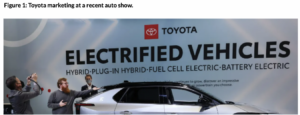
Labeling hybrids as EVs. In touting its “full spectrum of Electrified powertrains for consumers to choose from,”[98] Toyota has begun labeling every vehicle it sells—aside from legacy models with 100% traditional internal combustion engines—as “EVs,” including “Hybrid EV,” “Plug-in EV,” “Battery EV,” and “Fuel-Cell EV.”[99] See Figure 2.
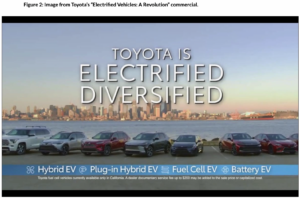
It is a major deception to put “electric,” “electric vehicle,” or “EV” in the name of vehicles regardless of how they are powered. Consumers typically understand the abbreviation “EV” to mean a fully electric vehicle—that is, a vehicle without an internal combustion engine.[100] This is the common usage of the phrase, both in everyday parlance and official designations. Indeed, Toyota’s corporate leaders themselves have employed the term “EV” to differentiate between all-electric vehicles and other cars, as then-CEO Akio Toyoda did during an anti-EV tirade in which he incorrectly claimed that “[t]he more EVs we build, the worse carbon dioxide gets.”[101] He was clearly using “EV” to refer to electric vehicles and not hybrids, whose superiority over EVs he was stressing.[102] As the Environmental Protection Agency’s Green Vehicle Guide states, “Electric vehicles (EVs) have a battery instead of a gasoline tank, and an electric motor instead of an internal combustion engine.”[103] Toyota’s use of the term “EV” to describe models—including the Tundra Hybrid, Sienna Hybrid, and Prius[104]—that do not “have a battery instead of a gasoline tank, and an electric motor instead of an internal combustion engine” is misleading.
Toyota has clearly made an intentional decision to begin describing its hybrids as EVs. The 2022 and 2023 Priuses are powered the same way—with gasoline. But on the 5th-generation Prius, introduced in 2023, Toyota stripped the word “hybrid”—which appeared on the car from its 1997 introduction until 2022[105]—and replaced it with a term consumers have never seen, “HEV,” and a new symbol. See Figure 3. These new markings give the distinct impression that the car is significantly different from traditional hybrids—indeed, from traditional Priuses—and that it uses some type of new “electric vehicle” or “EV” technology. It does not.
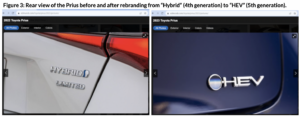
Toyota’s photo gallery for the 2023 Prius on its website includes a photo specifically highlighting this new label. See Figure 4.
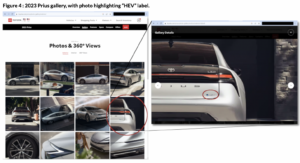
The confusion and harm from this deception is compounded by Toyota’s reputation as a leader on clean cars. Consumers are primed to believe that if Toyota is offering a new Prius called an “HEV” instead of a “hybrid,” the car must employ new, more advanced, electric or EV technology. But these rebrandings do not correspond to a change in the engine or any other technology in these cars. Indeed, unlike previous models, the 5th generation Prius scarcely improves on efficiency, which was the car’s original draw, compounding the harm of giving it the seemingly cleaner, higher-tech label of “HEV.” Instead, Toyota focused on giving the new Prius better power and acceleration,[106] no doubt another effort to stem its sales losses to EVs, which achieve these sporty qualities much more easily than hybrids[107] while being vastly greener.[108]
Toyota is employing similar tactics in its marketing of other models. Another ad, “Video Call: Camry Hybrid,” exemplifies how Toyota uses the modifier “electric” deceptively. In the ad a woman calls a friend to show off her new Camry Hybrid. The woman asks her friend, “Hey, do you see what I got? It’s a Toyota Hybrid Electric.” “Hybrid Electric?” the friend responds, emphasizing the phrase even further.[109] The term “Hybrid Electric” would seem to imply that the car runs on electricity in some meaningful way. It does not. But the misleading messages in this commercial do not end there. The woman goes on to exclaim, “Can you believe this driving range,”[110] evidently referring to the “686 Mile Range” prominently featured in the ad. See Figure 5. Toyota’s competitors—like BMW,[111] Ford,[112] and Chevrolet[113]—use “range” to reference the distance an EV can travel on a fully charged battery. They advertise their hybrid or combustion engine vehicles with MPG (miles per gallon).[114] Toyota’s unique use of “range” to describe a gas-powered hybrid’s distance traveled until empty might mislead a consumer who thinks it might be an EV, or more similar to an EV than is true.
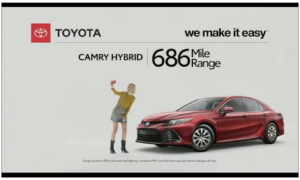
If the choices to describe the Camry as a “Hybrid Electric” and to rebrand the Prius from “hybrid” to “HEV” do not correspond to changes in the cars’ technology, what is the change based on? It is likely driven by the facts that genuine EVs outsold hybrids for the first time in 2022, and Tesla, which exclusively makes EVs, is on the verge of overtaking Toyota in California, the largest U.S. market and by far the biggest market for Toyota’s hybrids sales.[115] To augment an old saying: If you can’t beat them, join them—and if you can’t join them, pretend to.
Using blue bolts of electricity to advertise hybrids. To underscore the supposedly “electric” nature of its hybrids, Toyota has begun running advertisements featuring literal electricity. This imagery sends an extremely misleading message about the kind of energy that powers Toyota’s “hybrid electric vehicles,” which run entirely on gasoline.
For example, in one 30-second television spot titled “E-AWD Headquarters” a giant capital “E” is lifted by a crane while a voiceover declares, “Powerful all-wheel drive hybrid electric vehicles.”[116] See Figure 6. The phrase “Electrified Diversified” appears on the screen, framed by sparking lines of blue electricity.[117] The narrator continues, “Toyota is electrified, diversified, with more electrified all-wheel drive or four-wheel drive models than any other brand.”[118] Then with another burst of electricity the “E” is connected to a circuit board on a sign declaring Toyota the “E-AWD HEADQUARTERS.”[119] In fact, Toyota sells only one model of electric vehicle for which all-wheel drive is available as an option (and only one EV at all)—the bZ4X, for which it targeted sales of just 10,000 in the U.S for 2023.[120] Toyota sold 2.1 million vehicles in the U.S. 2022,[121] meaning that it aims for all-wheel drive electric vehicles to make up less than one-half of 1% of its sales. Whether viewed as a bait-and-switch or an attempt to misrepresent hybrids as electric vehicles, this practice is deceptive.[122]
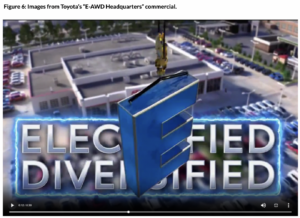
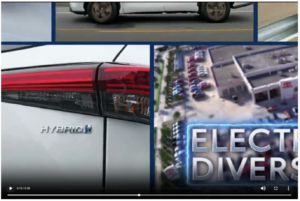

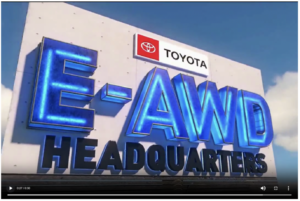
This lightning theme is not a one-off in the “E-AWD Headquarters” ad, but rather a regular visual in Toyota’s new advertising campaign. For example, another commercial, “Hybrid and Electrified,” features a clip of a Prius—a 100% gasoline-powered vehicle—getting struck by beams of electricity.[123] See Figure 7. Beyond merely misrepresenting this hybrid car as running on electricity, the image of a Prius being struck by lightning, along with a claim that the “all new Prius” is not just a hybrid, but “hybrid and electrified,” creates a false impression that the Prius has changed or evolved in some significant way.
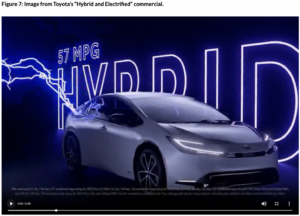
Claiming to offer “more electrified vehicles than any other brand.” Toyota also claims that it has “America’s largest electrified lineup”[124] and that it offers more “electrified” models than any other brand, creating an impression directly opposite of reality: In fact, Toyota offers fewer EVs than almost any competing automaker. Yet Toyota trumpets this claim across its advertising mediums, from television commercials to stadium advertisements at sporting events. See Figure 8. One 6-second digital spot consists solely of this message, with narration and text stating, in sum total, “Dear Freedom, Toyota has more electrified vehicles than any other brand.”[125] See Figure 9.
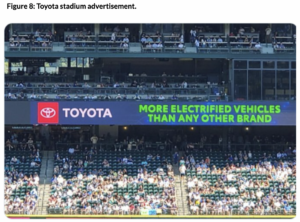
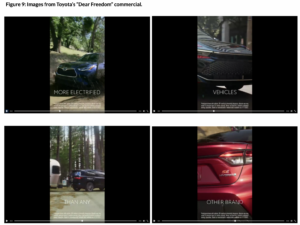
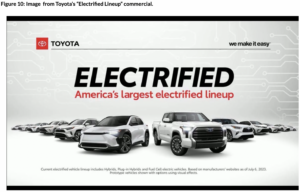
Consumers interested in “electric” or “electrified” vehicles are probably interested foremost in EVs. And for all practical purposes, Toyota offers none of them. It offers only two models and has targeted just 10,000 sales in 2023,[126] a figure that equals just 1.3% of the 756,534 new U.S. EV sales in 2022.[127] Collectively, Toyota and Lexus offered 21 models they call “electrified” in 2022. Just three were plug-in hybrids, and one was a fully electric vehicle.[128] Seventy-six percent of their so-called “electric” or “electrified” models—and 93% of sales—were just hybrids, meaning only somewhat more fuel-efficient gas-powered cars that are not meaningfully “electric” or “electrified” at all.
Highlighting vehicle charging. Another 30-second advertising spot in Toyota’s “Electrified Diversified” campaign further illustrates how Toyota deceptively represents its hybrid fleet as EVs. See Figure 11. The commercial features a woman charging her electric vehicle while a narrator declares that “Toyota is electrified, diversified, giving you the choice on how to reduce carbon emissions.”[129] These words and images imply that Toyota’s “electrified” cars are meaningfully electric, or at a minimum are plug-ins, when the vast majority of the cars featured in this advertisement and sold by Toyota are not.[130] Indeed, what Toyota overwhelmingly sells in what it calls the “electric” or “electrified” market are gasoline-powered hybrids. In 2022, Toyota sold only 31,644 plug-in hybrids and EVs in the U.S., or just 7% of the 448,854 vehicles it sold that it calls “electrified,” and 1.7% of the 1.85 million vehicles it sold overall.[131]
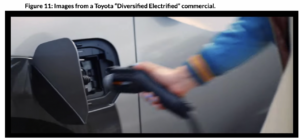
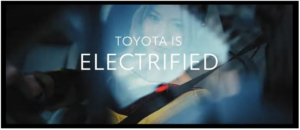
In another ad, titled “Beyond Zero: Carbon Footprint,” an image of Toyota’s “electrified” vehicles includes fully eight separate charging stations scattered throughout the 16-car lineup,[132] despite the fact that only three of those cars (two plug-in hybrids and one electric vehicle) have the capacity to plug into charging stations at all.[133] See Figure 12. This, in combination with the “Electrified Diversified” headline and the now-ubiquitous use of “EV” in the title of every type of car, creates the impression of a lineup that is overwhelmingly powered by electricity, when in reality the exact opposite is the case.
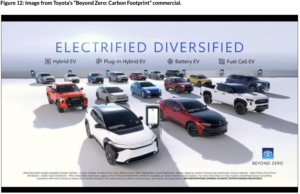
Lexus’s “To Each Their Own Electric” campaign. Toyota launched another misleading marketing campaign for its Lexus brand titled “To Each Their Own Electric.” Like its “Electrified Diversified” campaign, “To Each Their Own Electric” describes as “electric” a number of Lexus vehicles that run primarily or entirely on fossil fuels.[134] See Figure 13. In a 30-second advertising spot entitled “Agree to Disagree,” the narrator declares, “Hybrid, plug-in hybrid, EV. To each their own . . . electric.”[135] This advertisement is deceptive in multiple ways. First, it falsely claims that hybrids are a form of “electric.” It also projects equality between each of the car types discussed, strongly implying that each is equally available from Lexus. But Lexus scarcely offers EVs or plug-in hybrids at all. Lexus offers just one model of EV, with a 2023 sales target of 4,900,[136] and only one plug-in hybrid, which sold just 3,507 units in 2022.[137] For comparison, in 2022 Lexus sold 51,655 hybrid vehicles, meaning that 93.6% of the “electric” cars it sold were gasoline-powered hybrids.[138]
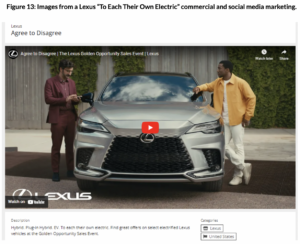
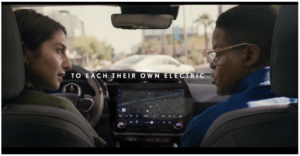
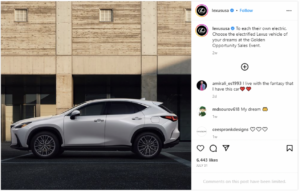
The advertising executive who created the “Agree to Disagree” ad states that it was intended to “position[]” Lexus as “an advocate of choice in a market that only offers one kind of electric technology.”[139] In other words, Lexus’s own marketing firm knows that consumers view “electric” as synonymous with only “one kind of electric technology”: fully electric vehicles. The marketers created an ad intended to destabilize that term and apply it to other types of cars—not the cars that consumers think of as electric, which they are demanding and Lexus’s competitors are producing at an “exponentially” growing rate,[140] but hybrid vehicles that Toyota and Lexus happen to offer in comparatively large numbers,[141] which are not meaningfully “electric” at all.
Lexus’s claim that hybrids are “self-charging.” The Lexus website adds one more misleading concept to this growing list of deceptive practices: the “self-charging” hybrid. At multiple points on its “Electrified” web page, Lexus describes its hybrid vehicles as having a “self-charging electric powertrain” or a “self-charging battery.”[142] See Figure 14. Presumably, Lexus is referring to the regenerative braking system. But in a hybrid, this system does nothing more than recapture energy from the 100% gasoline-powered engine. These hybrids do not “self-charge”—they need to recharge, or more accurately refuel, at gas stations, like traditional cars. If burning gasoline to charge a battery counts as “self-charging,” then all gasoline-powered vehicles are “self-charging,” since all traditional cars charge a 12 volt battery with an alternator.[143]
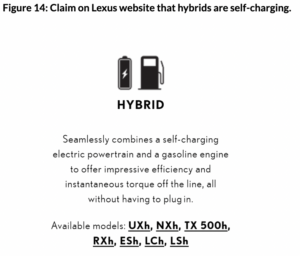
Toyota’s deceptive labeling of hybrids as “self-charging” seems to be even more common in Europe, where the practice has actually been targeted by regulators. In Norway, for example, Toyota had to pull down an ad using this phrasing after the Norwegian Consumer Authority ruled that it was “misleading” to describe the hybrid battery as self-charging because “the electricity produced by the car has consumption of gasoline as a necessary condition” and so could influence consumers “to make an economic decision that they would not otherwise have made.”[144] This language is just as misleading when used to sell hybrids in the U.S. Despite clear notice that the language is misleading, Toyota persists in using it.
2. Toyota’s claims of climate and environmental leadership are misleading.
A key idea Toyota is working to convey to consumers through its “electrification” claims is that the company’s “electrified vehicles are helping to reduce carbon emissions.”[145] Indeed, the company claims not only that it has “continued to drive CO2 emissions down” but that it has driven electrification “forward for everyone.”[146] This greenwashing, as articulated in Toyota’s “Beyond Zero” campaign and through misleading comparisons between hybrids and EVs, is directly opposite the reality of Toyota’s laggardly approach to the EV transition, without which U.S. and global climate goals cannot be achieved.
“Beyond Zero.” Toyota features the phrase “Beyond Zero” prominently on its website, in its advertising, and in other sponsored content. See Figures 15, 16 & 17. A sponsored feature in the publication Car and Driver titled “How Toyota’s Beyond Zero Philosophy Makes it Easy to Reduce Your Carbon Footprint” attempts to frame Toyota as a climate leader that is committed to “reducing carbon emissions” through a “Beyond Zero philosophy [that] extends to every part of the vehicle spectrum.”[147] The piece describes Toyota’s hybrid vehicles as “the easiest way to reduce your carbon footprint” and claims that “when you buy an electrified Toyota, you’re supporting a commitment to protecting the environment.”[148]
A 30-second spot titled “Beyond Zero: Carbon Neutrality” describes Beyond Zero as “Toyota’s vision to reach beyond carbon neutrality,” and features a cartoon of a Prius driving by green trees and Toyota-branded solar panels.[149] See Figure 15.


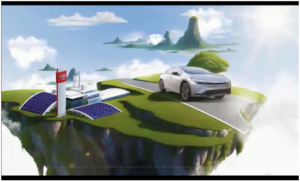
Another ad titled “Electrified Vehicles: A Revolution” begins with a voiceover claiming that Toyota is “leading the way towards carbon neutrality as part of Toyota’s ‘Beyond Zero’ vision, with more electrified choices, including hybrids.”[150] See Figure 16. The narrator goes on to claim that “Toyota is electrified, diversified, and we’re always looking to make a positive impact on the planet and society.”
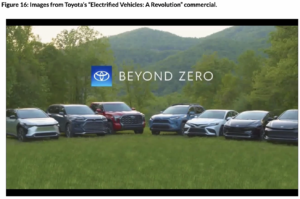
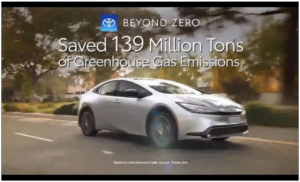
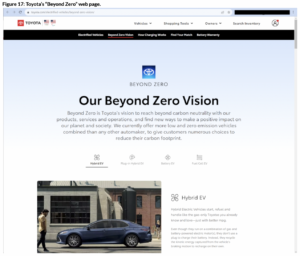
To consumers accustomed to hearing about zero-emissions vehicles, as well as government and corporate policies to achieve net zero emissions by 2050,[151] “beyond zero” signals a commitment to go “beyond” these efforts and do even better. Not content to rest on that implication, Toyota explicitly claims it has a “vision” to “reach beyond carbon neutrality.” See Figure 17. In reality, Toyota has refused to commit to zero emissions at all, much less to go “beyond” them.
Toyota’s refusal is a stark contrast with every other major automaker. Each of the ten largest automakers globally has committed to achieve 100% zero-emission vehicles by 2050 at the latest, aside from the two that already offer only EVs, Tesla and BYD.[152] Far from “leading the way towards carbon neutrality,” Toyota has argued that other companies’ zero emissions goals are unrealistic and has lobbied vigorously against policies that promote strong zero-emission targets, which numerous governments have adopted over its opposition.[153]
The only genuine relationship the phrase “beyond zero” bears to Toyota’s actions is that the company is pointedly not pursuing zero; it is doing something else. To claim it is going “beyond” zero when it is the industry’s worst laggard on “zero emissions”—the most important issue for automakers and customers today, and probably in automotive history—is grossly misleading.
This merits particular attention from the Commission given that Toyota announced that—in order to “shift the conversation about electrification” from its current focus on EVs—“Beyond Zero” will serve as the “framework for everything” the company communicates about its portfolio, signaling that the deception described above will be a “constant part” of Toyota’s paid advertising for the foreseeable future.[154]
Lexus’s 90-to-1 comparison. On its website, Lexus provides another misleading argument for favoring hybrids over EVs if one is concerned about climate change—that a focus on hybrids leads to “more electrified vehicles on the road.”[155] See Figure 18. Lexus claims that because of limited supplies of the minerals needed to produce lithium batteries, prioritizing hybrids over EVs—whose batteries, the company claims, require roughly 90 times the materials used in a hybrid battery—“spread[s] out” these resources so that Lexus “can produce more low emission vehicles.” In another location, an explainer about its “Beyond Zero” campaign, Toyota notes that the EV in this 90-to-1 comparison is a GMC Hummer EV.[156] The Hummer is massive—the largest available EV, more than twice the weight of a best-selling Tesla[157]—and it is manufactured by General Motors, not Toyota. This omission alone makes Toyota’s 90-to-1 claim grossly misleading. But the bigger problem is that hybrid emissions are not comparable to those of EVs. As discussed at length in this complaint, hybrids are gasoline-powered vehicles, and their emissions are substantially more similar to those of conventional cars.[158] In addition to the deception of calling hybrids “electrified,” the assertion that producing 90 hybrids rather than one EV is good for the climate is profoundly misleading. Putting 90 additional climate-polluting, gasoline-powered vehicles on the road is not the best way to lower emissions or support the environment, and Lexus’s representations to the contrary are deceptive.[159]
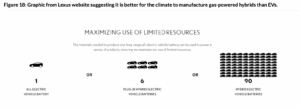
3. It is reasonable for consumers to find Toyota’s practices misleading.
A national poll by Data For Progress found that 62% of likely voters understand the term “electric vehicles” or “EVs” to mean a vehicle that does not have an internal combustion engine and instead operates entirely on electricity, while only 8% of respondents considered vehicles that have an internal combustion engine and are powered by gasoline but use electricity to enhance efficiency to be EVs.[160] It is reasonable, then, for consumers to find Toyota misleading when it uses terminology that most consumers understand signifies particular characteristics to describe vehicles that have very different characteristics.
This is particularly true considering the growing complexity of the automotive market in recent years. Consumers are being confronted with a range of evolving automotive trends, technologies, and terminologies regarding powertrain design, as a 2022 qualitative research report commissioned by the UK’s independent advertising regulator concluded.[161] The study found that the car purchasing process is becoming significantly more challenging for consumers due to the need to navigate new technology and the language used to describe it, and that consumers “struggled to make sense” of where different powertrains fit on a spectrum of environmental progress.[162] Consumers also reported concerns that there was no straightforward source of information and advice on this topic, and expressed a desire for an independent source of guidance “written in plain English” to clarify issues such as green relativity.[163] Given this context of market complexity and consumer uncertainty, it is not unreasonable for consumers to find the marketing practices described above to be deceptive and misleading.
B. Toyota’s deception is material.
According to the FTC, a “material” representation “is one which is likely to affect a consumer’s choice of or conduct regarding a product.”[164] In other words, it is information that is “important to consumers.”[165] Toyota’s “Electrified Diversified,” “To Each Their Own Electric,” and “Beyond Zero” advertising campaigns and the various other marketing practices described in this complaint convey information that is important to consumers for both environmental and economic reasons.
A 2021 survey of 8,500 consumers found that nearly two-thirds of consumers are “sustainability-minded drivers” who rated themselves as very or extremely environmentally concerned.[166] Transportation is the largest cause of U.S. greenhouse gas pollution,[167] and switching to an electric vehicle can be one of the most impactful consumer actions many people can take to reduce emissions.[168] Accurate information about whether or not Toyota’s offerings are “electric” is certainly important to these climate-conscious consumers.
Consumers also have concrete economic reasons to choose EVs, which save users money through tax incentives and lower energy and maintenance costs. EVs can be expected to produce an average of $800 to $1,000 a year in savings on fueling costs over gasoline-powered cars,[169] or $14,500 over a longer period of time.[170] EVs also have lower regular maintenance costs; one study found that they cost 4 cents less per mile to maintain than gas-powered cars, leading to average savings of $8,000 over 15 years.[171] Because of these attributes, a 2020 Consumer Reports study found that an average EV owner saves between $6,000 and $10,000 over the life of the vehicle, even taking into account EVs’ higher sticker prices.[172] Moreover, the price of EVs continues to fall such that they are nearing sticker-price parity, increasing these total savings. In October 2023, the starting price of the best-selling EV, the Tesla Model Y, dropped to $3,700 below the average price of a new vehicle in the U.S.[173] Purchasers of EVs can also receive substantial incentives and rebates that hybrids are not eligible for,[174] including federal tax credits of up to $7,500 for new electric vehicles and up to $4,000 for used ones, with additional programs at the state and local levels.[175]
Consumers understand these advantages, with one recent survey finding that, among respondents who would consider purchasing an EV, 70% said that saving money on gas was a major reason why.[176] Another survey found that around 3 in 10 U.S. adults were interested in purchasing an EV because they believed its energy, maintenance, and lifetime costs are lower than those of gas cars.[177] The same survey found that over half of respondents had heard that public incentives were available for electric vehicle owners.[178]
As such, Toyota’s deceptive marketing of hybrid vehicles—which do not produce such savings—as “electric,” “electrified,” and “EVs” conveys false information on a matter that is important to cost-minded consumers. These misleading representations raise a significant risk of concrete monetary harm to consumers, who may purchase a vehicle expecting far greater long-term economic benefits from fuel costs, reduced maintenance needs, and tax credits than they ultimately receive.
C. Toyota’s deceptive marketing violates the FTC Green Guides.
Toyota’s advertising represents a range of vehicles as “electric,” “electrified,” and “EVs” when they are not primarily electric—or in many cases, are not electric in any meaningful way at all. This marketing violates important principles articulated in the FTC Green Guides. Although the Green Guides do not explicitly address claims related to electric vehicles (they were last updated in 2012, before EVs were a major consumer good), certain sections are instructive.
The Green Guides’ discussion of “Renewable Materials Claims” advises that marketers should “qualify any ‘made with renewable materials’ claim unless the product or package (excluding minor, incidental components) is made entirely with renewable materials.”[179] Similarly, the section on “Renewable Energy Claims” warns that marketers should not make “unqualified renewable energy claims, directly or by implication,” if “fossil fuel, or electricity derived from fossil fuel, is used to manufacture any part of the advertised item or . . . power any part of the advertised service.”[180] To illustrate this principle, the Green Guides offer examples such as this: “A marketer advertises its clothing line as “made with wind power.” The marketer buys wind energy for 50% of the energy it uses to make the clothing in its line. The marketer’s claim is deceptive because reasonable consumers likely interpret the claim to mean that the power was composed entirely of renewable energy.”[181]
If it is deceptive to claim that a product made with 50% wind is “made with wind power,” then Toyota is plainly making deceptive claims about its hybrids. Toyota advertises its hybrids as “electric,” “electrified,” and “self-charging” even though they primarily run on fossil fuels, even using fossil fuels to recharge their batteries. Similarly, Toyota calls its hybrids “hybrid EVs,” implying that they are substantially like EVs in some way. But the most relevant and salient characteristic is how the cars are powered—and hybrids run on gasoline, whereas EVs run on electricity. Not content to rest on a misleading implication that a so-called “electrified” vehicle is not powered by gasoline—or that a “Hybrid EV” or “HEV” runs on electricity in some meaningful way—Toyota goes further, as shown in Figure 12 above: It specifically distinguishes its hybrids from “gas-only” cars, saying that hybrids run on “a combination of gas and battery-powered electric motor(s)” and recharge the hybrid battery “on their own” through regenerative braking. The full text is as follows: “Even though [hybrids] run on a combination of gas and battery-powered electric motor(s), they don’t use a plug to charge their battery. Instead, they recycle the kinetic energy captured from the vehicle’s braking motion to recharge on their own.”[182]
Toyota completely neglects to mention that a hybrid’s battery is also, perhaps primarily, charged by the gasoline engine. The gasoline engine will switch on to recharge the battery if it falls too low even when the car is merely idling.[183] In addition, the gasoline engine is ultimately required even for regenerative braking. A car cannot use regenerative braking to recover energy unless it is propelled in the first place—and hybrids are propelled primarily by their gasoline engines. Without gasoline, the car can scarcely drive. Indeed, Toyota’s website advises that its hybrids could suffer “severe damage” if driven at all without gasoline.[184]
Toyota’s claims here are substantially worse than the marketing described in the Green Guides’ wind power example and flatly run afoul of the principle, articulated at multiple points throughout the FTC Green Guides, that advertising is deceptive if it implies that a product relies primarily on clean sources when in reality it relies only partially on such sources—or, in the case of hybrids, not even partially.
D. Toyota’s deceptive marketing is in a league of its own.
Although Toyota’s representation of gasoline-powered cars as “electrified” is not unique in the automotive industry, Toyota is deploying this message in particularly deceptive ways and at a scale unlike that of any other company.
In response to this complaint, Toyota might argue that it is not alone in labeling non-EVs as “electrified.” One important response is of course that a practice is no less deceptive merely because multiple companies engage in it. Indeed, if multiple companies are deceiving consumers in a similar manner, there is likely a gross breakdown in the market, with firms competing through deception rather than providing useful, accurate information, and the Commission’s intervention is needed all the more.
To the degree that other companies have used or are beginning to use “electrified” language, their uses highlight the particularly deceptive nature of Toyota’s marketing and illustrate why it is so urgent that the FTC take action to stop this damaging trend before it worsens.
Toyota was not the first company to discuss “electrifying” its fleet. Perhaps the earliest major automaker to mount a public relations campaign highlighting fleet “electrification” was Volvo. In 2017 Volvo announced a plan to go “all electric,” declaring that “Volvo Cars will introduce a portfolio of electrified cars across its model range,” comprising both “fully electric cars” and hybrids for “one of the broadest electrified car offerings of any car maker.”[185] While this “electrified” language is similar to Toyota’s, the context is very different, in ways that help illustrate why Toyota’s marketing is so deceptive. Unlike Toyota, Volvo used these terms while announcing ambitious EV goals, including plans to launch five fully electric vehicles between 2019 and 2021.[186] Volvo then continued expanding on that commitment, with an announcement in 2021 that it aims for 50% of its global sales to be EVs by 2025 and 100% by 2030, at which point “the company intends to only sell fully electric cars and phase out any car in its global portfolio with an internal combustion engine, including hybrids.”[187] In other words, Volvo used “electrified” language to describe the process of actually electrifying its fleet—converting its line-up to fully electric cars—which is an appropriate description that aligns with the commonly understood usage of these terms. That common usage—and the aura of leadership that Volvo has genuinely earned—is precisely what Toyota is attempting to evoke with its “Electrified Diversified” marketing campaign and its claim that it offers “more electrified vehicles than any other brand.” These claims are deceptive precisely because, unlike Volvo, Toyota is last among all major automakers in both EV progress and commitments and is using these evocations to mislead consumers about its laggard status. Toyota has made no commitment to electrify its fleet by any date. It has lagged far behind competitors on taking even initial steps. And it is actively fighting policies that favor genuine electrification, doubtless because those policies threaten an automaker that is failing to electrify.
Toyota is also not the only company currently using the language of “electrified vehicles.” Several automakers feature this phrase or similar ones on their websites. Some of these instances further highlight Toyota’s deception. For example, Stellantis uses the terms “electrification” and “electrified vehicles” on its website, but only to refer to fully electric vehicles, not hybrids.[188] By contrast, Honda, Hyundai, Land Rover, and Mazda each feature lists of “electrified vehicles” on their websites that include some combination of EVs, plug-ins, and hybrids.[189] To the degree that this misleading language is being adopted by other automakers, such creeping usage underlines why it is so important—and urgent—for the FTC to crack down on these deceptive practices before they further destabilize the EV market.
E. Toyota’s deceptive marketing threatens the broader EV market.
In addition to harming specific consumers, Toyota’s deceptive practices are fundamentally degrading the information that structures the broader EV market. If manufacturers categorize cars that run primarily or entirely on fossil fuels as “electric” or “EVs,” then what do those words even mean? How can manufacturers who are genuinely electrifying their lineups communicate to consumers when their truthful and widely accepted usage is co-opted and redefined by laggards who are, in fact, far behind on electrification and even actively resisting it?
Toyota’s misleading claims are also generating confusion beyond the company’s own marketing. For example, as shown in Figure 19, the Washington, DC Auto Show includes a Toyota plug-in hybrid, the Prius Prime, in its “Electric” rather than its “Hybrid” category.[190]
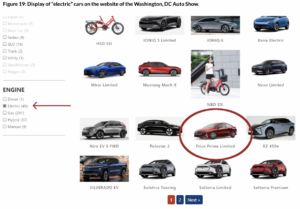
All markets require good information to function properly. But the need for clarity is especially strong in the EV market, for several reasons:
- The EV sector is highly dynamic, with major recent innovations, new vehicle types, and dozens if not hundreds of new models being introduced in the near future. With so many novel factors to learn about and consider, consumers face a particularly daunting challenge when it comes to making informed decisions.
- Cars are not trivial goods. A car is a massive household purchase—one of the most expensive goods an average American pays for over their lifetime,[191] and the second leading source of non-mortgage debt among U.S. consumers in 2023.[192]
- Transportation is the largest cause of U.S. greenhouse gas pollution.[193] This is an area of major concern for most consumers, and switching to an electric vehicle may be one of the most impactful consumer actions many people can take to reduce emissions.
- Reducing transportation emissions and promoting EVs are major priorities of federal and state policy.[194]
All of these factors make Toyota’s misleading marketing particularly alarming and destructive.
IV. The FTC should stop these violations of the FTC Act.
It is critical that the FTC address these deceptive marketing practices, both to ensure that Toyota stops engaging in such misleading advertising and to clarify to all automakers that the representation and marketing of gasoline-powered cars as electric vehicles is prohibited under the FTC Act.
The FTC should investigate and take enforcement action against Toyota. Toyota’s marketing of cars with internal combustion engines as “electric,” “electrified,”“EVs,” or “self-charging” is deceptive, and the FTC should investigate these practices and take enforcement action seeking a permanent injunction and any other appropriate relief for the company’s violations of the FTC Act.
The FTC should issue clear policy guidance on electric vehicle marketing. The market for electric vehicles is one of the most important and dynamic in the U.S. economy. Maintaining clarity about what does and does not constitute an “EV” is critical to the market functioning properly and consumers making choices that meet their intentions regarding costs, convenience, and climate change. Currently the FTC Green Guides do not mention this vital sector, and no clear guidance exists regarding electrification claims.
The FTC’s policy guidance documents are of high value to businesses attempting to comply with the FTC Act. Although the public comment period for the updated Green Guides has closed, the FTC should make clear in the new Green Guides that the marketing of gasoline-powered cars as “EVs,” “electric,” “electrified,” or “self-charging” is deceptive and prohibited under Section 5 of the FTC Act.
V. Conclusion
Climate necessity and consumer preference have combined to make electric vehicles the way of the future. But rather than commit fully to converting its line-up to meet this consumer demand, Toyota has opted for a different strategy—misleading consumers into believing that its fleet of internal combustion engine-based vehicles are actually “electric.” To this end, Toyota has engaged in a greenwashing marketing campaign to overstate the environmental and economic benefits of its hybrid models, using the term “electrified” to imply that vehicles that run on fossil fuels are actually “EVs.” These deceptive representations are likely to mislead consumers in violation of Section 5(a) of the FTC Act. The Commission has a statutory mandate to protect consumers against such practices. To fulfill its obligations under the law, the FTC should investigate and take enforcement action against Toyota for these acts.
Moreover, Toyota’s misleading practices threaten to corrode the information ecosystem necessary to foster a healthy EV market, which represents one of the most important sectors in the U.S. economy. For the benefit of consumers, fair competition, and a livable future, the Commission should update its policy guidance to clarify that deceptive marketing like Toyota’s is not permissible.
Respectfully submitted,
Aaron Regunberg, Senior Policy Counsel
David Arkush, Director
Public Citizen’s Climate Program
1600 20th Street, NW
Washington DC, 20009
(202) 588-1000
[1] Mike Costello, Toyota remains world’s biggest car company, Car Expert (Jan. 30, 2023), https://www.carexpert.com.au/car-news/toyota-remains-worlds-biggest-car-maker.
[2] Hiroko Tabuchi, Toyota Led on Clean Cars. Now Critics Say It Works to Delay Them, The New York Times (Jul. 25, 2021), https://www.nytimes.com/2021/07/25/climate/toyota-electric-hydrogen.html.
[3] International Energy Agency, Global EV Outlook 2023, 8 (2023),
https://www.iea.org/reports/global-ev-outlook-2023/executive-summary.
[4] Toyota’s muddling of ordinary usage in this area made it difficult even to write this complaint, so a clarifying note may be necessary: In this complaint, the terms “EVs” and “electric vehicles” are used in the way those terms are ordinarily understood—to refer to battery electric vehicles, also knowns as BEVs, which run exclusively on electricity drawn from the electric grid and stored in a battery onboard the vehicle. This aligns with the Environmental Protection Agency’s Green Vehicle Guide, which defines electric vehicles as vehicles that “have a battery instead of a gasoline tank, and an electric motor instead of an internal combustion engine.” Green Vehicle Guide: Electric & Plug-In Hybrid Electric Vehicles, Environmental Protection Agency (Aug. 28, 2023), https://www.epa.gov/greenvehicles/electric-plug-hybrid-electric-vehicles.
[5] A national poll by Data For Progress found that 62% of likely voters understand the term “electric vehicles” or “EVs” to mean a vehicle that does not have an internal combustion engine and instead operates entirely on electricity. Only 8% of respondents considered vehicles that have an internal combustion engine and are powered by gasoline but use electricity to enhance efficiency to be EVs, while 23% considered both types of vehicles to be EVs. Notably, the poll found that voters across partisanship and education generally hold similar views about which types of vehicles align with their understanding of EVs. Grace Adcox, Charged with Deceit: Defining the “Electric” in Electric Vehicles, Data For Progress (Nov. 30, 2023), https://www.dataforprogress.org/blog/2023/11/30/charged-with-deceit-defining-the-electric-in-electric-vehicles.
[6] Jack Ewing, U.S. Electric Car Sales Climb Sharply Despite Shortages, The New York Times (Jul. 14, 2022), https://www.nytimes.com/2022/07/14/business/electric-car-sales.html.
[7] International Energy Agency, Global EV Outlook 2023, 8 (2023),
https://www.iea.org/reports/global-ev-outlook-2023.
[8] Maggie Dennis, Are We on the Brink of an Electric Vehicle Boom? Only with More Action, World Resources Institute (Sept. 16, 2021), https://www.wri.org/insights/what-projected-growth-electric-vehicles-adoption.
[9] Sean Tucker, EV Sales Broke Records in First Quarter of 2023, Kelley Blue Book (Apr. 12, 2023), https://www.kbb.com/car-news/ev-sales-broke-records-in-first-quarter-of-2023/.
[10] Sean McLain, Automakers Have Big Hopes for EVs; Buyers Aren’t Cooperating, Wall Street Journal (Oct. 15, 2023), https://www.wsj.com/business/autos/electric-vehicle-buyer-interest-67b407cb.
[11] Stephanie Brinley, EV Chargers: How many do we need?, S&P Global Mobility (Jan. 9, 2023), https://www.spglobal.com/mobility/en/research-analysis/ev-chargers-how-many-do-we-need.html.
[12] KPMG, 22nd Annual Automotive Executive Survey 2021, 8 (2021), https://kpmg.com/xx/en/home/insights/2021/11/global-automotive-executive-survey-2021.html.
[13] See generally David Wallace-Wells, Electric Vehicles Keep Defying Almost Everyone’s Expectations, The New York Times (Jan. 11, 2023), https://www.nytimes.com/2023/01/11/opinion/electric-vehicles-sales-growth-tesla.html.
[14] International Energy Agency, Global EV Outlook 2021, 5-6 (2021), https://www.iea.org/reports/global-ev-outlook-2021.
[15] International Energy Agency, Global EV Outlook 2023, 8 (2023),
https://www.iea.org/reports/global-ev-outlook-2023.
[16] See Maggie Dennis, Are We on the Brink of an Electric Vehicle Boom? Only with More Action, World Resources Institute (Sept. 16, 2021), https://www.wri.org/insights/what-projected-growth-electric-vehicles-adoption.
[17] An S-curve describes the market diffusion process of new technologies, where growth starts out slow but then, as technology costs fall and complementary infrastructure is developed, adoption grows exponentially.
[18] Bruce Einhorn and Nao Sano, The World’s Love Affair with Japanese Cars Is Souring, Bloomberg (Jan. 5, 2023), https://www.bloomberg.com/news/features/2023-01-06/toyota-nissan-risk-status-loss-as-tesla-vw-byd-top-global-electric-car-market.
[19] Toyota bets big on hydrogen as an alternative route to carbon neutrality, Just Auto (Nov. 18, 2021), https://www.just-auto.com/features/toyota-bets-big-on-hydrogen-as-an-alternative-route-to-carbon-neutrality.
[20] Hydrogen fuel cell vehicles are not comparable to EVs in their potential to reduce climate pollution. Currently, more than 99% of U.S. hydrogen production is sourced from fossil fuels, primarily through “steam methane reforming,” an energy-intensive process in which methane gas is broken down into hydrogen and carbon dioxide. See Office of Fossil Energy, Hydrogen Strategy: Enabling a Low-Carbon Economy, 5 (July 2020), https://www.energy.gov/sites/prod/files/2020/07/f76/USDOE_FE_Hydrogen_Strategy_July2020.pdf. While “green hydrogen” can be produced through electrolysis powered by renewable energy, this is a costly process. Hydrogen leakage is also a climate concern—although hydrogen does not trap heat directly, it combines with other chemical compounds in the atmosphere to cause warming that is significantly more potent than CO2 in the short term. See David Baker, Miracle Fuel Hydrogen Can Actually Make Climate Change Worse, Bloomberg (May 31, 2022), https://www.bloomberg.com/news/features/2022-05-31/hydrogen-fuel-investments-could-risk-making-global-warming-worse. In other words, even if the technology were working better, hydrogen combustion is not clean, and reducing climate pollution is one major driver of consumer EV adoption and the principal driver of government policies favoring EVs.
[21] Scooter Doll, Honda CEO says Toyota’s strategy to pursue hydrogen combustion ‘doesn’t seem feasible’, Electrek (Jan. 20, 2022), https://electrek.co/2022/01/20/honda-ceo-says-toyotas-strategy-to-pursue-hydrogen-cars-doesnt-seem-feasible.
[22] Alec Macfarlane, Toyota dumps stake in Tesla as former partners become rivals, CNN Business (Jun. 5, 2017), https://money.cnn.com/2017/06/05/investing/toyota-sells-tesla-stake/index.html.
[23] Peter Landers, Toyota’s Chief Says Electric Vehicles Are Overhyped, Wall Street Journal (Dec. 17, 2020), https://www.wsj.com/articles/toyotas-chief-says-electric-vehicles-are-overhyped-11608196665.
[24] Norihiko Shirouzo, Exclusive: Toyota scrambles for EV reboot with eye on Tesla, Reuters (Oct. 24, 2022), https://www.reuters.com/business/autos-transportation/exclusive-toyota-scrambles-ev-reboot-with-eye-tesla-2022-10-24/.
[25] Justin Westbrook, Toyota Is Pulling a 180 On Its Weak EV Strategy and Working to Adopt the Tech Sooner, MotorTrend (Oct. 24, 2022), https://www.motortrend.com/news/toyota-ev-strategy-sales-panic-electric-cars-akio-toyoda.
[26] Peter Johnson, Toyota reveals next-gen EV production line as it looks to play catch-up with Tesla, Electrek (Sept. 19, 2023), https://electrek.co/2023/09/19/toyota-reveals-next-gen-ev-production-line-catch-up-tesla.
[27] Roland Irles, Global EV Sales for 2023 H1, EV Volumes, https://www.ev-volumes.com.
[28] Abigail Bassett, The Toyota bZ4X: Solidly middling EV, TechCrunch (Apr. 15, 2022), https://techcrunch.com/2022/04/15/the-toyota-bz4x-ev-solidly-middling.
[29] Mark Kane, US: Toyota Plug-In Car Sales Decreased By A Third In 2022, Inside EVs (Jan. 8, 2023), https://insideevs.com/news/629813/us-toyota-plugin-car-sales-2022q4/.
[30] Joey Capparella, Toyota Stays Modest About EVs as It Relaunches bZ4X After Recall, Car and Driver (Jan. 24, 2023), https://www.caranddriver.com/news/a42624715/2023-toyota-bz4x-on-sale-relaunch.
[31] Mark Kane, US: Toyota Plug-In Car Sales Increased In Q2 2023 By 27%, Inside EVs (Jul. 10, 2023), https://insideevs.com/news/676057/us-toyota-plugin-car-sales-2023q2.
[32] Ron Sessions, 2023 Lexus RZ Review, J.D. Power (Mar. 13, 2023) https://www.jdpower.com/cars/expert-reviews/2023-lexus-rz-review-driving-impressions.
[33] Mark Kane, US: Toyota Plug-In Car Sales Increased In Q2 2023 By 27%, Inside EVs (Jul. 10, 2023), https://insideevs.com/news/676057/us-toyota-plugin-car-sales-2023q2/.
[34] Dan Mihalascu, Tesla Outsold Its Next 19 Competitors Combined in US in H1 2023, InsideEVs (Sept. 29, 2023), https://insideevs.com/news/689106/tesla-outsold-its-next-19-competitors-combined-in-us-h1-2023/; 3,659 bZ4X + 1,117 RZ 450e = 4,776 Toyota U.S. EV sales; 325,291 Tesla U.S. sales / 4,776 = 68.
[35]Rurika Imahashi, Toyota aims to sell 3.5m EVs in 2030, shedding laggard image, Nikkei Asia (Dec. 14, 2021), https://asia.nikkei.com/Business/Automobiles/Toyota-aims-to-sell-3.5m-EVs-in-2030-shedding-laggard-image.
[36] Kazuaki Nagata, Toyota’s new leadership aims for 10 new battery EV models by 2026, The Japan Times (Apr. 7, 2023), https://www.japantimes.co.jp/news/2023/04/07/business/toyota-ev-models-sales-2026/.
[37] Lexus, a division of Toyota, has committed to 100% EV sales by 2035.
[38] Chris Chilton, BMW Expects To Smash 50% EV Sales Goal Before Own 2030 Deadline, Carscoops (Mar. 15, 2023), https://www.carscoops.com/2023/03/bmw-expects-to-smash-50-ev-sales-goal-before-own-2030-deadline/.
[39] Ford to Lead America’s Shift to Electric Vehicles, Ford (Sept. 27, 2021), https://media.ford.com/content/fordmedia/fna/us/en/news/2021/09/27/ford-to-lead-americas-shift-to-electric-vehicles.html.
[40] Michael Wayland, General Motors plans to exclusively offer electric vehicles by 2035, CNBC (Jan. 28, 2021), https://www.cnbc.com/2021/01/28/general-motors-plans-to-exclusively-offer-electric-vehicles-by-2035.html.
[41] Maria Merano, Honda to step up its game with new electric motorcycles and EVs, Teslarati (Apr. 25, 2023), https://www.teslarati.com/honda-electric-vehicle-sales-goal-2025/.
[42] Andrew Hawkins, Mercedes-Benz says it will go all-electric in 2030, but with a major caveat, The Verge (Jul. 22, 2021), https://www.theverge.com/2021/7/22/22588587/mercedes-benz-electric-ev-2030-caveat.
[43] Stellantis Ventures to aid ‘Dare Forward 2030’ plan, makes 11 key investments, ET Auto (Jun. 15, 2023), https://auto.economictimes.indiatimes.com/news/industry/stellantis-ventures-to-aid-dare-forward-2030-plan-makes-11-key-investments/101025826.
[44] Volkswagen Takes its Electric Ambitions Up Another Notch with New Targets for 2030, Frost & Sullivan (Jun. 15, 2023), https://www.frost.com/frost-perspectives/volkswagen-takes-its-electric-ambitions-up-another-notch-with-new-targets-for-2030/.
[45] The Future is Electric, Volvo, https://group.volvocars.com/company/innovation/electrification.
[46] Volvo Cars to Sell Only EVs by 2030, Auto Dealer Today (Sept. 20, 2023), https://www.autodealertodaymagazine.com/371992/volvo-cars-to-only-sell-evs-by-2030.
[47] To be clear, all of the automaker commitments and projections discussed here fall short of what is needed to meet the science-based target of limiting global warming to 1.5°C. For example, the International Council on Clean Transportation found that 77% of vehicle sales must be zero-emission by 2030 just to meet at 2°C target, with significantly more needed to align with a 1.5°C pathway. See International Council on Clean Transportation, The Global Automaker Rating 2022: Who Is Leading the Transition to Electric Vehicles? 1 (2022), https://theicct.org/wp-content/uploads/2023/05/The-Global-Automaker-Rating-2022_final.pdf. Still, all are superior to Toyota’s projections and lack of commitments.
[48] International Energy Agency, Global EV Outlook 2023, 8 (2023), https://www.iea.org/reports/global-ev-outlook-2023/executive-summary.
[49] New EV entries nibbling away at Tesla EV share, according to S&P Global Mobility, S&P Global Mobility (Nov. 29, 2022), https://press.spglobal.com/2022-11-29-New-EV-entries-nibbling-away-at-Tesla-EV-share,-according-to-S-P-Global-Mobility. The report notes that the same is true of Honda.
[50] José Rodríguez Jr., Toyota Owners Trade Their Cars for EVs More Than Any Other Brand: Report, Jalopnik (Apr. 28, 2023), https://jalopnik.com/toyota-owners-trade-cars-for-evs-more-than-other-brands-1850386992.
[51] Eri Sugiura, Toyota leasing unit warns of ‘unprecedented’ challenge to boost EV sales, Financial Times (Jun. 13, 2023), https://www.ft.com/content/d4bec71c-c787-4a76-b479-01ac63f5a427.
[52] See, e.g., Norihiko Shirouzo, Exclusive: Toyota scrambles for EV reboot with eye on Tesla, Reuters (Oct. 24, 2022), https://www.reuters.com/business/autos-transportation/exclusive-toyota-scrambles-ev-reboot-with-eye-tesla-2022-10-24/; Norihiko Shirouzo, Focus: Toyota looks to overhaul EV strategy as new CEO takes charge, Reuters (Apr. 6, 2023), https://www.reuters.com/business/autos-transportation/toyota-looks-overhaul-ev-strategy-new-ceo-takes-charge-2023-04-06/.
[53] Hiroko Tabuchi, Toyota Led on Clean Cars. Now Critics Say It Works to Delay Them, The New York Times (Jul. 25, 2021), https://www.nytimes.com/2021/07/25/climate/toyota-electric-hydrogen.html.
[54] Chris Chilton, Toyota Says Data Proves EV-Only Policy Is Worse for the Planet, Carscoops (Jan. 31, 2023), https://www.carscoops.com/2023/01/toyota-says-data-proves-ev-only-policy-is-worse-for-the-planet/.
[55] See, e.g., Michael Wayland, Why Toyota – the world’s largest automaker – isn’t all-in on electric vehicles, CNBC (Sept. 13, 2022), https://www.cnbc.com/2022/09/13/why-toyota-the-worlds-largest-automaker-isnt-all-in-on-evs.html.
[56] Jameson Dow, Toyota says there’s no EV demand – maybe try selling one the wheels stay on?, Electrek (Aug. 25, 2022), https://electrek.co/2022/08/25/toyota-says-no-ev-demand-try-selling-one-wheels-dont-fall-off/.
[57] Eric Wesoff & Dan McCarthy, Chart: US EV sales are having a record-setting year, Canary Media (Nov. 17, 2023), https://www.canarymedia.com/articles/electric-vehicles/chart-us-ev-sales-are-having-a-record-setting-year.
[58] Toyota Launches ‘Electrified Diversified’ Beyond Zero Campaign, Toyota (Sept. 18, 2023), https://pressroom.toyota.com/toyota-launches-electrified-diversified-beyond-zero-campaign/.
[59] Toyota USA, Beyond Zero Electrified Diversified | Toyota, YouTube (Sept. 18, 2023), https://www.youtube.com/watch?v=6I7PjciLBEc&ab_channel=ToyotaUSA.
[60] See FACT SHEET: Biden-Harris Administration Announces New Private and Public Sector Investments for Affordable Electric Vehicles, The White House (Apr. 17, 2023), https://www.whitehouse.gov/briefing-room/statements-releases/2023/04/17/fact-sheet-biden-harris-administration-announces-new-private-and-public-sector-investments-for-affordable-electric-vehicles/; Austin Igleheart, see also State Policies Promoting Hybrid and Electric Vehicles, National Conference of State Legislatures (Aug. 23, 2023), https://www.ncsl.org/energy/state-policies-promoting-hybrid-and-electric-vehicles.
[61] See Types of Electric Vehicles, EVgo, https://www.evgo.com/ev-drivers/types-of-evs/ (noting that battery electric vehicles are “more frequently called EVs”); see also Chanel Lee, Types of Electric Vehicles, Autotrader (May 25, 2022), https://www.autotrader.com/car-shopping/types-of-electric-vehicles (noting that “EVs don’t run on gasoline or use internal combustion engines”).
[62] David Reichmuth, Are Electric Vehicles Really Better for the Climate? Yes, Here’s Why, Union of Concerned Scientists (Feb. 11, 2020), https://blog.ucsusa.org/dave-reichmuth/are-electric-vehicles-really-better-for-the-climate-yes-heres-why/.
[63] EVs Offer Big Savings Over Traditional Gas-Powered Cars, Consumer Reports (Oct. 8, 2020), https://www.consumerreports.org/hybrids-evs/evs-offer-big-savings-over-traditional-gas-powered-cars.
[64] John O’Dell, What Is An EV?, Forbes (Dec. 22, 2021), https://www.forbes.com/wheels/advice/what-is-an-ev/.
[65] The Cost of Electric Vehicles, AAA Automotive, https://www.aaa.com/autorepair/articles/true-cost-of-ev.
[66] Lynn Walford, EVs are Roomier and Here’s Why, LifeWire (Sept. 29, 2021), https://www.lifewire.com/why-evs-are-roomier-5202177.
[67] Federal Tax Credits for Plug-In Electric and Fuel Cell Electric Vehicles Purchased in 2023 or After, fueleconomy.gov, https://www.fueleconomy.gov/feg/tax2023.shtml.
[68] How Do Hybrid Electric Cars Work?, Alternative Fuels Data Center, https://afdc.energy.gov/vehicles/how-do-hybrid-electric-cars-work.
[69] Id.
[70] Transport and Environment, UK Briefing: The Plug-In Hybrid Con (Briefing Paper, September 2020), https://www.transportenvironment.org/wp-content/uploads/2021/07/2020_09_UK_briefing_The_plug-in_hybrid_con.pdf.
[71] Compare Side-by-Side, FuelEconomy.gov, https://fueleconomy.gov/feg/Find.do?action=sbs&id=47117&id=47119&id=47129&id=47131.
[72] Zeeshan Hyder, Hybrid v.s Electric Cars: 2023 Cost Guide, Solar Reviews (Jan. 23, 2023), https://www.solarreviews.com/blog/hybrids-versus-electric-cars.
[73] Id.
[74] Charger Types and Speed, U.S. Department of Transportation, https://www.transportation.gov/rural/ev/toolkit/ev-basics/charging-speeds.
[75] Keith Barry, Is a Plug-In Hybrid Vehicle Right for You?, Consumer Reports (Sept. 25, 2023), https://www.consumerreports.org/cars/hybrids-evs/is-a-plug-in-hybrid-vehicle-right-for-you-a9339147016/.
[76] Types of Electric Vehicles, EVgo, https://www.evgo.com/ev-drivers/types-of-evs/
[77] See, e.g., Hybrid vs. Plug-In Hybrid: Everything You Need to Know, CoPilot (Mar. 31, 2022), https://www.copilotsearch.com/posts/hybrid-vs-plug-in-hybrid-what-to-know/.
[78] Zeeshan Hyder, Hybrid v.s Electric Cars: 2023 Cost Guide, Solar Reviews (Jan. 23, 2023), https://www.solarreviews.com/blog/hybrids-versus-electric-cars.
[79] Jameson Dow, Another study shows plug-in hybrids are dirtier than we thought, Electrek (Feb. 8, 2023), https://electrek.co/2023/02/08/another-study-shows-plug-in-hybrids-are-dirtier-than-we-thought/.
[80] Stephen Edelstein, Study: PHEVs aren’t plugged in as often as regulators assume, Green Car Reports (Dec. 27, 2022), https://www.greencarreports.com/news/1138255_study-phevs-aren-t-plugged-in-as-often-as-regulators-assume.
[81] These discrepancies are not the subject of this complaint, but they do illustrate the misleading nature of Toyota’s attempts to paint plug-in hybrids as EVs, given that fully electric vehicles perform vastly better in relevant respects regardless of window stickers.
[82] The International Council on Clean Transportation (ICCT), A Global Comparison of the Life-Cycle Greenhouse Gas Emissions of Combustion Engine and Electric Passenger Cars 28 (White Paper, July 2021), https://theicct.org/wp-content/uploads/2021/07/Global-Vehicle-LCA-White-Paper-A4-revised-v2.pdf.
[83] Id.
[84] Id.
[85] Id.
[86] Devin Pratt, What Is a Reasonable Lifespan for a Modern Car?, Consumer Reports (Aug. 20, 2023), https://www.consumerreports.org/cars/car-reliability-owner-satisfaction/what-is-a-reasonable-life-span-for-a-modern-car-a4678774857/ (most cars are capable of 200,000 miles, or approximately 322,000 kilometers).
[87] 250 g CO2 eq./km x 322,000km = 80,500kg.
[88] 150 g CO2 eq./km x 322,000km = 48,300kg.
[89] 100 g CO2 eq./km x 322,000km = 32,200kg.
[90] 50 g CO2 eq./km x 322,000km = 16,100kg.
[91] It should be noted that EVs last longer than vehicles with internal combustion engines. The longer a car lasts, the less that production emissions should factor into its overall emissions—meaning that these numbers may underestimate the differential in emissions between EVs and hybrids.
[92] This is an estimate based on the information provided in the ICCT report cited above, as the report does not explicitly reference this figure.
[93] 15 U.S.C. § 45 (2012).
[94] Cliffdale Associates, Inc., 103 F.T.C. 110, 170–71 (1984).
[95] Toyota Launches ‘Electrified Diversified’ Beyond Zero Campaign, Toyota (Sept. 18, 2023), https://pressroom.toyota.com/toyota-launches-electrified-diversified-beyond-zero-campaign/.
[96] How Toyota’s Beyond Zero Philosophy Makes it Easy to Reduce Your Carbon Footprint, Car and Driver (Nov. 6, 2023), https://www.caranddriver.com/features/a45596184/how-toyotas-beyond-zero-philosophy-makes-it-easy-to-reduce-your-carbon-footprint. In light of Toyota’s habit of disparaging plug-in hybrids and EVs in advertisements and public statements, the Commission should investigate whether the company and Toyota dealers engage in the bait-and-switch practice of advertising these plug-in hybrids and EVs to lure consumers to engage with them, then disparaging these vehicles in an effort to sell other cars instead. See FTC, Synopsis of Federal Trade Commission Decisions Concerning “Bait and Switch” Sales Practices, Apr. 7, 2022, https://www.ftc.gov/system/files/ftc_gov/pdf/Bait-Switch.pdf (“It is an unfair or deceptive trade practice to disparage an advertised product for the purpose of ‘switching’ a customer to the purchase of another product.”).
[97] See supra note 5.
[98] Toyota Launches ‘Electrified Diversified’ Beyond Zero Campaign, Toyota (Sept. 18, 2023), https://pressroom.toyota.com/toyota-launches-electrified-diversified-beyond-zero-campaign/
[99] Toyota TV Spot, ‘Electrified Vehicles: A Revolution’ [T2], iSpot.tv (Oct. 3, 2023), https://www.ispot.tv/ad/5fVu/toyota-electrified-vehicles-a-revolution-t2.
[100] See supra note 5.
[101] Peter Landers, Toyota’s Chief Says Electric Vehicles Are Overhyped, Wall Street Journal (Dec. 17, 2020), https://www.wsj.com/articles/toyotas-chief-says-electric-vehicles-are-overhyped-11608196665.
[102] Id.
[103] Green Vehicle Guide: Electric & Plug-In Hybrid Electric Vehicles, Environmental Protection Agency (Aug. 28, 2023), https://www.epa.gov/greenvehicles/electric-plug-hybrid-electric-vehicles.
[104] Toyota Launches ‘Electrified Diversified’ Beyond Zero Campaign, Toyota (Sept. 18, 2023), https://pressroom.toyota.com/toyota-launches-electrified-diversified-beyond-zero-campaign/.
[105] See Prius, Toyota, https://global.toyota/en/mobility/toyota-brand/gallery/prius.html.
[106] Jaclyn Trop, The new 2023 Toyota Prius plays up power, not fuel economy, TechCrunch (Nov. 16, 2022), https://techcrunch.com/2022/11/16/2023-toyota-prius-plays-up-power-not-fuel-economy/.
[107] John Voelcker, Why Are EVs So Quick?, Car and Driver (Feb. 1, 2022), https://www.caranddriver.com/features/a38887851/why-are-evs-so-quick.
[108] See supra Part II.D.
[109] Toyota Camry Hybrid TV Spot, ‘Video Call: Camry Hybrid’ [T2], iSpot.tv (Jan. 5, 2023), https://www.ispot.tv/ad/2iYv/toyota-camry-hybrid-video-call-camry-hybrid-t2.
[110] Id.
[111] See, e.g., Range Farther Afield, BMW USA, https://www.bmwusa.com/vehicles/all-electric/i4/gran-coupe/overview.html#range-and-charging, accessed 12/11/2023.
[112] See, e.g., 2023 Mustang Mach-E, Ford, https://www.ford.com/suvs/mach-e/?gnav=header-electrified-vhp, accessed 12/11/2023.
[113] See, e.g., All-Electric 2023 Bolt EV, Chevrolet, https://www.chevrolet.com/electric/bolt-ev, accessed 12/11/2023/
[114] See, e.g., X7 xDrive40i, BMW USA, https://www.bmwusa.com/vehicles/x-models/x7/sports-activity-vehicle/core-models.html#features-and-specifications, accessed 12/11/2023; 2024 Mustang EcoBoost Fastpack, Ford, https://www.ford.com/cars/mustang/models/ecoboost-fastback/#:~:text=Packages-,Specifications,-Build%20%26%20Price, accessed 12/11/2023; 2024 Blazer, Chevrolet, https://www.chevrolet.com/suvs/blazer, accessed 12/11/2023.
[115] Stephen Edelstein, Tesla topped Toyota in California deliveries in Q2, Green Car Reports (Jul. 26, 2023), https://www.greencarreports.com/news/1140308_tesla-topped-toyota-in-california-deliveries-in-q2.
[116] Toyota TV Spot, ‘E-AWD Headquarters’ [T2], iSpot.tv (Sept. 10, 2023), https://www.ispot.tv/ad/5Zj7/toyota-e-awd-headquarters-t2.
[117] Id.
[118] Id.
[119] Id.
[120] Joey Capparella, Toyota Stays Modest About EVs as It Relaunches bZ4X After Recall, Car and Driver (Jan. 24, 2023), https://www.caranddriver.com/news/a42624715/2023-toyota-bz4x-on-sale-relaunch.
[121] Toyota defends title as world’s top-selling automaker in 2022, Reuters, Jan. 29, 2023, https://www.reuters.com/business/autos-transportation/toyota-defends-title-worlds-top-selling-automaker-2022-2023-01-30/.
[122] The FTC defines a “bait and switch” as “the advertising of a product without the bona fide intention to sell it, for the purpose of establishing contact with a prospective customer in order to induce or ‘switch’ him to purchase another product.” See FTC, Synopsis of Federal Trade Commission Decisions Concerning “Bait and Switch” Sales Practices, Apr. 7, 2022, https://www.ftc.gov/system/files/ftc_gov/pdf/Bait-Switch.pdf. Two factors evidencing a bait-and-switch are whether “in fact” there were “a significant number of sales of the advertised product at the advertised price,” and whether there were “large advertising expenditures for a product whose sales were minimal.” Id.
[123] Toyota TV Spot, ‘Hybrid and Electrified’ [T2], iSpot.tv (Sept. 6, 2023), https://www.ispot.tv/ad/5of7/toyota-hybrid-and-electrified-t1.
[124] Toyota TV Spot, ‘Electrified Lineup’ [T2], iSpot.tv (Nov. 12, 2023), https://www.ispot.tv/ad/5C59/toyota-electrified-lineup-t2.
[125] Drive Toyota, Dear Freedom, Toyota has more electrified vehicles than any other brand, Pinterest, https://www.pinterest.com/pin/dear-freedom-toyota-has-more-electrified-vehicles-than-any-other-brand-yours-toyota-video-in-2023–909234612252145484/.
[126] Jack Ewing and Ben Dooley, Toyota, a Hybrid Pioneer, Struggles to Master Electric Vehicles, The New York Times (Sept. 7, 2023), https://www.nytimes.com/2023/09/07/business/toyota-hybrid-electric-vehicles.html
[127] Dan Mihalascu, EVs Made Up 5.6 Percent Of US Car Market In 2022 Driven By Tesla, InsideEVs (Feb. 20, 2023), https://insideevs.com/news/653395/evs-made-up-5point6-percent-of-overall-us-car-market-in-2022-driven-by-tesla/.
[128] Toyota Motor North America Reports Year-End 2022 U.S. Sales Reports, Toyota Motor North America (Jan. 4, 2023), https://www.prnewswire.com/news-releases/toyota-motor-north-america-reports-year-end-2022-us-sales-results-301713474.html.
[129] Toyota USA, Beyond Zero Electrified Diversified | Toyota, YouTube (Sept. 18, 2023), https://www.youtube.com/watch?v=6I7PjciLBEc&ab_channel=ToyotaUSA.
[130] For an international comparison, the Advertising Standards Authority (ASA)—the self-regulatory organization of the advertising industry in the UK—recently concluded that two Nissan ads about “electrified” hybrids were misleading. These ads followed a Nissan Qashqai traveling around the city followed by a spark of electricity. The ad stated “FUELLED BY PETROL DRIVEN BY ELECTRIC” in on-screen text. Despite this disclaimer, the ASA ruled that because the ads “as a whole strongly emphasised [sic] the role of electricity in the car, the extent of the role petrol had in powering the car was unclear.” It also found that the ads implied the hybrid was a “better choice for the environment than traditionally fuelled vehicles,” but that this was misleading because they “did not make sufficiently clear the nature of the vehicle’s power source” and that this source, petrol, “would produce tailpipe emissions.” ASA Ruling on Nissan Moter (GB) Ltd n/a Nissan Motor (GB) Ltd, Advertising Standards Authority (Oct. 18, 2023), https://www.asa.org.uk/rulings/nissan-motor–gb–ltd-g23-1206694-nissan-motor–gb–ltd.html. These ads, with their “FUELLED BY PETROL” disclaimer, arguably provide much more clarity about the energy sources powering Nissan’s hybrid than Toyota’s “Electrified Diversified” ad, which provides no disclaimer or reference to the gasoline that powers Toyota’s hybrid vehicles.
[131] These figures are calculated from data in Toyota Motor North America Reports Year-End 2022 U.S. Sales Reports, TOYOTA MOTOR NORTH AMERICA (Jan. 4, 2023), https://www.prnewswire.com/news-releases/toyota-motor-north-america-reports-year-end-2022-us-sales-results-301713474.html.
[132] Toyota TV Spot, ‘Beyond Zero: Carbon Footprint’ [T2], iSpot.tv (Nov. 1, 2023), https://www.ispot.tv/ad/5lU4/toyota-beyond-zero-vision-carbon-footprint-t2.
[133] Our Beyond Zero Vision, Toyota, https://www.toyota.com/electrified-vehicles/beyond-zero-vision.
[134] Ann Truong, LEXUS – Agree to Disagree, Vimeo (Jul. 10, 2023), https://vimeo.com/844070391. Lexus is owned by Toyota.
[135] Id.
[136] Ron Sessions, 2023 Lexus RZ Review, J.D. Power (Mar. 13, 2023), https://www.jdpower.com/cars/expert-reviews/2023-lexus-rz-review-driving-impressions.
[137] Toyota Motor North America Reports Year-End 2022 U.S. Sales Reports, Toyota Motor North America (Jan. 4, 2023), https://www.prnewswire.com/news-releases/toyota-motor-north-america-reports-year-end-2022-us-sales-results-301713474.html.
[138] Id.
[139] Agree to Disagree, Lexus, Philipp Dietz, https://philippdietz.com/Agree-To-Disagree-New.
[140] International Energy Agency, Global EV Outlook 2023, 8 (2023), https://www.iea.org/reports/global-ev-outlook-2023/executive-summary.
[141] Toyota group’s global auto sales top in 2022 for 3rd straight year, Kyodo News (Jan. 30, 2023), https://english.kyodonews.net/news/2023/01/e4ca137df021-urgent-toyota-groups-global-auto-sales-top-in-2022-for-3rd-straight-year.html (noting that Toyota sold 2.73 million hybrids in 2022 alone).
[142] All Electrified. All Lexus., Lexus, https://www.lexus.com/electrified.
[143] Jameson Dow, Toyota’s anti-EV ads aren’t just deceptive, they also push anti-science illiteracy, Electrek (Jun. 18, 2019), https://electrek.co/2019/06/18/toyota-push-science-illiteracy-deceptive-anti-ev-ads.
[144] Fred Lambert, Toyota’s ‘self-charging hybrid’ ad is banned in Norway, deemed a lie, Electrek (Jan. 24, 2020), https://electrek.co/2020/01/24/toyota-self-charging-hybrid-ad-banned-norway-lie.
[145] Toyota Launches ‘Electrified Diversified’ Beyond Zero Campaign, Toyota (Sept. 18, 2023), https://pressroom.toyota.com/toyota-launches-electrified-diversified-beyond-zero-campaign/
[146] All Electrified. All Lexus., Lexus, https://www.lexus.com/electrified.
[147] How Toyota’s Beyond Zero Philosophy Makes it Easy to Reduce Your Carbon Footprint, Car and Driver (Nov. 6, 2023), https://www.caranddriver.com/features/a45596184/how-toyotas-beyond-zero-philosophy-makes-it-easy-to-reduce-your-carbon-footprint.
[148] Id.
[149] Toyota TV Spot, ‘Beyond Zero: Carbon Footprint’ [T2], iSpot.tv (Nov. 1, 2023), https://www.ispot.tv/ad/5lU4/toyota-beyond-zero-vision-carbon-footprint-t2.
[150] Toyota TV Spot, ‘Electrified Vehicles: A Revolution’ [T2], iSpot.tv (Oct. 3, 2023), https://www.ispot.tv/ad/5fVu/toyota-electrified-vehicles-a-revolution-t2.
[151] As of June of this year 929 companies from the Forbes 2000 list have set net zero targets. See Net zero targets among world’s largest companies double, but credibility gaps undermine progress, Net Zero Tracker (Jun. 12, 2023), https://zerotracker.net/insights/net-zero-targets-among-worlds-largest-companies-double-but-credibility-gaps-undermine-progress.
[152] In addition to Toyota, Tesla, and BYD, the 10 largest automakers are Volkswagen, Stellantis, Mercedes Benz, Ford, General Motors, Honda, and Nissan.
[153] Hiroko Tabuchi, Toyota Led on Clean Cars. Now Critics Say It Works to Delay Them, The New York Times (Jul. 25, 2021), https://www.nytimes.com/2021/07/25/climate/toyota-electric-hydrogen.html.
[154] Beyond Zero: New Campaign Unifies EV Messaging Around Carbon Emission Reduction, Toyota Newsroom (Nov. 9, 2023), https://pressroom.toyota.com/beyond-zero-new-campaign-unifies-ev-messaging-around-carbon-emission-reduction/.
[155] All Electrified. All Lexus., Lexus, https://www.lexus.com/electrified.
[156] Beyond Zero: New Campaign Unifies EV Messaging Around Carbon Emission Reduction, Toyota Newsroom (Nov. 9, 2023), https://pressroom.toyota.com/beyond-zero-new-campaign-unifies-ev-messaging-around-carbon-emission-reduction/.
[157] The Hummer EV weighs over 9,000 pounds. Austin Lott, 2022 GMC Hummer EV Weight, Range and Battery Size Revealed, Edmunds, Feb. 17, 2022, https://www.edmunds.com/car-news/2022-gmc-hummer-ev-range-battery-pack-and-weight-revealed.html. By contrast, the best-selling Tesla Model Y weighs 4,416 points. Dustin Hawley, How Much Does A Tesla Weigh?, J.D. Power, Apr. 23, 2023, https://www.jdpower.com/cars/shopping-guides/how-much-does-a-tesla-weigh.
[158] See The International Council on Clean Transportation, A Global Comparison of the Life-Cycle Greenhouse Gas Emissions of Combustion Engine and Electric Passenger Cars (White Paper, July 2021), https://theicct.org/wp-content/uploads/2021/07/Global-Vehicle-LCA-White-Paper-A4-revised-v2.pdf.
[159] Toyota’s basic claim about mineral supply is also contested. There are more than enough accessible lithium reserves on the planet to power the EV transition, and while production bottlenecks are an issue, lithium mining technology and efficiency continue to improve. See Hannah Ritchie, Does the world have enough lithium to move to electric vehicles?, Sustainability by Numbers (Jan. 5, 2023), https://www.sustainabilitybynumbers.com/p/lithium-electric-vehicles.
[160] See supra note 5.
[161] This research was conducted in the UK, where the automotive market is similar enough to the U.S. context that it seems reasonable to assume U.S. consumers are experiencing similar challenges.
[162] Advertising Standards Authority, Environmental Claims in Advertising: Qualitative Research Report, 3–4 (Oct. 2022), https://www.asa.org.uk/static/6830187f-cc56-4433-b53a4ab0fa8770fc/CCE-Consumer-Understanding-Research-2022Final-090922.pdf.
[163] Id.
[164] Cliffdale Associates, Inc., 103 F.T.C. 110, 170–71 (1984).
[165] Id.
[166] Busting automotive sustainability myths, Accenture (Sept. 6, 2021), https://www.accenture.com/us-en/insights/automotive/busting-automotive-sustainability-myths.
[167] Climate Action, U.S. Department of Transportation, https://www.transportation.gov/priorities/climate-and-sustainability/climate-action.
[168] See, e.g., Center for Climate and Energy Solutions, Reducing Your Transportation Footprint, https://www.c2es.org/content/reducing-your-transportation-footprint/.
[169] EVs Offer Big Savings Over Traditional Gas-Powered Cars, Consumer Reports (Oct. 8, 2020), https://www.consumerreports.org/hybrids-evs/evs-offer-big-savings-over-traditional-gas-powered-cars.
[170] Will Kaufman, Electric Cars vs. Gas Cars: What’s the Difference?, Carmax (Aug. 1, 2023), https://www.carmax.com/articles/electric-cars-vs-gas-cars.
[171] Id.
[172] Benjamin Preston, EVs Offer Big Savings Over Traditional Gas-Powered Cars, Consumer Reports (Oct. 8, 2020), https://www.consumerreports.org/hybrids-evs/evs-offer-big-savings-over-traditional-gas-powered-cars.
[173] Tom Randall, Tesla Prices Now Rival Average US Cars After Billions in Cuts, Bloomberg (Oct. 9, 2023), https://www.bloomberg.com/news/articles/2023-10-09/tesla-prices-now-rival-average-us-cars-after-billions-in-cuts.
[174] Some plug-in hybrids are also eligible for these credits.
[175] Id.
[176] Alison Spencer, Stephanie Ross, and Alec Tyson, How Americans view electric cars, Pew Research Center (Jul. 13, 2023), https://www.pewresearch.org/short-reads/2023/07/13/how-americans-view-electric-vehicles/.
[177] Jeff Bartlett, More Americans Would Buy an Electric Vehicle, and Some Consumers Would Use Low-Carbon Fuels, Survey Shows, Consumer Reports (Jul. 7, 2022), https://www.consumerreports.org/cars/hybrids-evs/interest-in-electric-vehicles-and-low-carbon-fuels-survey-a8457332578.
[178] Id.
[179] 16 CFR § 260.16 (emphasis added).
[180] 16 CFR § 260.15 (emphasis added).
[181] Id.
[182] Our Beyond Zero Vision, Toyota, https://www.toyota.com/electrified-vehicles/beyond-zero-vision.
[183] Laurance Yap, How Hybrid Cars Work, Green Cars (July 2023), https://www.greencars.com/greencars-101/how-hybrid-cars-work.
[184] Can a conventional hybrid vehicle run on electricity when it runs out of fuel?, Toyota, https://support.toyota.com/s/article/Can-a-conventional-hy-7666, visited Nov. 11, 2023 (“Can a conventional hybrid vehicle run on electricity when it runs out of fuel? No. Though a hybrid vehicle can operate in electric-only mode when gasoline is in the tank, it is not designed to run without gasoline. Doing so could cause severe damage to the hybrid system, so drivers should be sure to keep gas in the tank at all times.”).
[185] Volvo Cars to go all electric, Volvo (Jul. 5, 2017), https://www.media.volvocars.com/global/en-gb/media/pressreleases/210058/volvo-cars-to-go-all-electric.
[186] Id.
[187] Volvo Cars to be fully electric by 2030, Volvo (Mar. 2, 2021), https://www.media.volvocars.com/us/en-us/media/pressreleases/277409/volvo-cars-to-be-fully-electric-by-2030.
[188] Electrification, Stellantis, https://www.stellantis.com/en/technology/electrification.
[189] Electrified Vehicles, Honda, https://automobiles.honda.com/vehicle-electrification (describing EVs and hybrids); Hyundai Electrified Vehicles, Hyundai, https://www.hyundaiusa.com/us/en/electrified (describing EVs, plug-ins, and hybrids); Land Rover Electrified Vehicles, Land Rover, https://www.landroverusa.com/electric/suv.html (describing plug-ins and hybrids); Electrified Vehicles, Mazda, https://www.mazdausa.com/why-mazda/electric-vehicles (describing plug-ins).
[190] See Our Vehicles, Washington DC Auto Show, https://washingtonautoshow.com/show-brands/vehicles/?_engine_type=electric, accessed 11/11/2023.
[191] Liz Knueven, The 7 most expensive things you’ll ever pay for, according to financial planners, Insider (Aug. 15, 2019), https://www.businessinsider.com/personal-finance/most-expensive-things-americans-will-pay-for-2019-8#7-health-insurance-1.
[192] Leading sources of non-mortgage debt among consumers in the United States in 2023, Statista, https://www.statista.com/statistics/944954/personal-debt-source-usa/.
[193] Climate Action, U.S. Department of Transportation, https://www.transportation.gov/priorities/climate-and-sustainability/climate-action.
[194] See FACT SHEET: Biden-Harris Administration Announces New Private and Public Sector Investments for Affordable Electric Vehicles, The White House (Apr. 17, 2023), https://www.whitehouse.gov/briefing-room/statements-releases/2023/04/17/fact-sheet-biden-harris-administration-announces-new-private-and-public-sector-investments-for-affordable-electric-vehicles/; Austin Igleheart, see also State Policies Promoting Hybrid and Electric Vehicles, National Conference of State Legislatures (Aug. 23, 2023), https://www.ncsl.org/energy/state-policies-promoting-hybrid-and-electric-vehicles.
